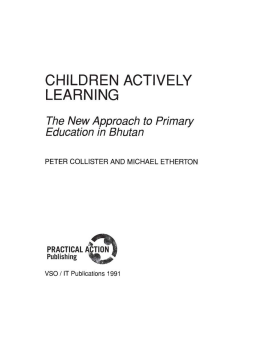
Additional Information
Book Details
Abstract
This text relates the introduction of child-centred and discovery methods of education into the primary education system of Bhutan since 1986. It offers lessons to those in other small countries in the developing world who are embarking on curricular and methodological reform of formal education for younger children. Looking at how the new scheme, NAPE, relates to previous educational methods and organization in Bhutan in both the lay and monastic education systems, it considers the history of the scheme to date, and looks at the elements which have contributed to its success, as well as its failures and shortcomings. The authors highlight the role of external professional volunteers, from agencies in the UK, Ireland, New Zealand and Canada, and from United Nations volunteers, in planning and implementing the new system through placements in Bhutanese schools and teacher training institutions. Guidance is offered to other agencies who may face similar situations elsewhere.
Table of Contents
| Section Title | Page | Action | Price |
|---|---|---|---|
| Title Page | i | ||
| Copyright Page | ii | ||
| Table of Contents | iii | ||
| Foreword | v | ||
| Introduction | 1 | ||
| The Case Study | 5 | ||
| 1: Modern Primary Education | 5 | ||
| 2: The context: The Kingdom of Bhutan | 6 | ||
| Geography | 6 | ||
| National Life | 7 | ||
| Foreign Policy | 7 | ||
| 3: The Implications for Education | 8 | ||
| The Monasteries | 8 | ||
| Religion in the Lay Community | 9 | ||
| Authoritarianism | 10 | ||
| Dependence on Expatriates | 11 | ||
| Demography and Language Usage | 12 | ||
| 4: The Development of the Secular Education System | 13 | ||
| 5: The Nape Pilot Scheme and its Antecedents | 15 | ||
| The New National Plan for Education | 15 | ||
| The Syllabus of the New National Plan | 16 | ||
| A Note on the EVS syllabus | 18 | ||
| 1986: Birth of NAPE | 20 | ||
| 1988: UNICEF NAPE Evaluation | 21 | ||
| 1988: Backlash | 23 | ||
| 6: 1990-91: Nape Extended Countrywide Policy | 24 | ||
| 7: Nape and Schooling for Girls | 26 | ||
| 8: Nape: Applicability Elsewhere | 27 | ||
| 9: Elements Contributing to Success | 29 | ||
| Political Will | 29 | ||
| Co-Operation | 30 | ||
| Size | 30 | ||
| Volunteers | 30 | ||
| Bhutanese Society | 31 | ||
| 10: Failures, Shortcomings and Pitfalls | 32 | ||
| Shortage of Teachers and Poor Administration | 32 | ||
| Lack of Involvement of Teacher Training Institutes (TTIs) | 33 | ||
| 11: Selection, Training and Professional Support of Volunteers | 34 | ||
| Summary: Lessons for Others | 37 | ||
| Relevant Reports | 39 | ||
| Appendix I: The Nape syllabus | 41 | ||
| Appendix II: From the 'New Approach to Primary Education, Environmental Studies, Teachers' Manual for Pre-Primary Classes' | 47 | ||
| Appendix III: Role of the Resource Teacher in the New Approach to Primary Education (NAPE) Programme (1989) | 50 | ||
| Appendix IV: Role of Dzongkhag-Based Resource Personnel in the New Approach to Primary Education (NAPE) Programme (1990) | 55 |
